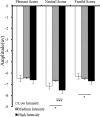Early Influence of Emotional Scenes on the Encoding of Fearful Expressions With Different Intensities: An Event-Related Potential Study
- PMID: 35652009
- PMCID: PMC9150066
- DOI: 10.3389/fnhum.2022.866253
Early Influence of Emotional Scenes on the Encoding of Fearful Expressions With Different Intensities: An Event-Related Potential Study
Abstract
Contextual affective information influences the processing of facial expressions at the relatively early stages of face processing, but the effect of the context on the processing of facial expressions with varying intensities remains unclear. In this study, we investigated the influence of emotional scenes (fearful, happy, and neutral) on the processing of fear expressions at different levels of intensity (high, medium, and low) during the early stages of facial recognition using event-related potential (ERP) technology. EEG data were collected while participants performed a fearful facial expression recognition task. The results showed that (1) the recognition of high-intensity fear expression was higher than that of medium- and low-intensity fear expressions. Facial expression recognition was the highest when faces appeared in fearful scenes. (2) Emotional scenes modulated the amplitudes of N170 for fear expressions with different intensities. Specifically, the N170 amplitude, induced by high-intensity fear expressions, was significantly higher than that induced by low-intensity fear expressions when faces appeared in both neutral and fearful scenes. No significant differences were found between the N170 amplitudes induced by high-, medium-, and low-intensity fear expressions when faces appeared in happy scenes. These results suggest that individuals may tend to allocate their attention resources to the processing of face information when the valence between emotional context and expression conflicts i.e., when the conflict is absent (fear scene and fearful faces) or is low (neutral scene and fearful faces).
Keywords: ERP; N170; P1; emotional scenes; fear expression; intensity.
Copyright © 2022 Song, Wu and Feng.
Conflict of interest statement
The authors declare that the research was conducted in the absence of any commercial or financial relationships that could be construed as a potential conflict of interest.
Figures





Similar articles
-
Early integration of affectively contextual information when processing low-intensity fearful faces: Behavioral and electrophysiological evidence.Int J Psychophysiol. 2020 Oct;156:1-9. doi: 10.1016/j.ijpsycho.2020.07.001. Epub 2020 Jul 12. Int J Psychophysiol. 2020. PMID: 32663482
-
Rapid influence of emotional scenes on encoding of facial expressions: an ERP study.Soc Cogn Affect Neurosci. 2008 Sep;3(3):270-8. doi: 10.1093/scan/nsn021. Soc Cogn Affect Neurosci. 2008. PMID: 19015119 Free PMC article.
-
You are that smiling guy I met at the party! Socially positive signals foster memory for identities and contexts.Acta Psychol (Amst). 2015 Jul;159:1-7. doi: 10.1016/j.actpsy.2015.05.001. Epub 2015 May 19. Acta Psychol (Amst). 2015. PMID: 26000956
-
Meanness and affective processing: A meta-analysis of EEG findings on emotional face processing in individuals with psychopathic traits.Biol Psychol. 2024 Mar;187:108764. doi: 10.1016/j.biopsycho.2024.108764. Epub 2024 Feb 11. Biol Psychol. 2024. PMID: 38350594 Review.
-
Attention and emotion: An integrative review of emotional face processing as a function of attention.Cortex. 2020 Sep;130:362-386. doi: 10.1016/j.cortex.2020.06.010. Epub 2020 Jul 6. Cortex. 2020. PMID: 32745728 Review.
Cited by
-
Validation of the Emotionally Congruent and Incongruent Face-Body Static Set (ECIFBSS).Behav Res Methods. 2025 Jan 3;57(1):41. doi: 10.3758/s13428-024-02550-w. Behav Res Methods. 2025. PMID: 39753781
References
-
- Bai L., Mao W., Wang R., Zhang W. (2017). The effect of emotional scene and body expression on facial expression recognition. Acta Psychol. Sin. 49 1172–1183. 10.3724/sp.j.1041.2017.01172 - DOI
-
- Beck A. T., Steer R. A. (1993). Beck Anxiety Inventory Manual. San Antonio, TX: Psychological Corporation
LinkOut - more resources
Full Text Sources

